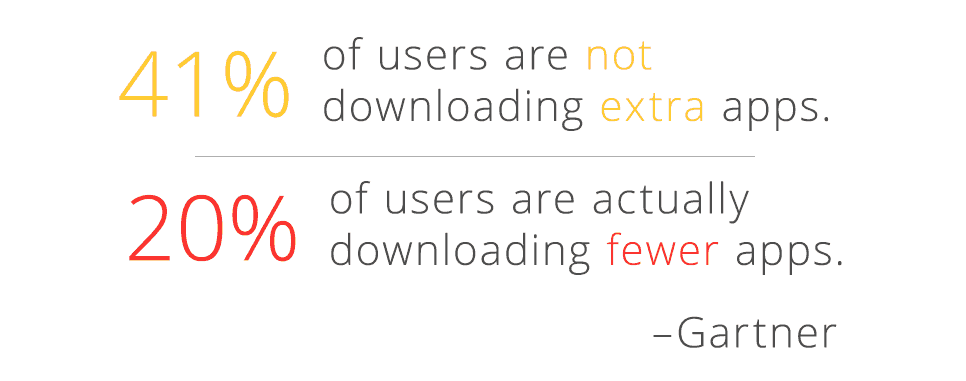Think about the apps on your smartphone. You’ve probably downloaded dozens of them, but how many do you use on a regular basis?
Research from comScore finds that mobile users spend 85 percent of their time using just five apps. Moreover, a Gartner survey shows that 41 percent of users are not downloading more apps while 20 percent are actually downloading fewer apps.

It’s clear that consumers are suffering from “app fatigue” and have hit a ceiling on the number of apps that they are willing to download and use. While enterprise IT leaders may be quick to write off app fatigue as a concern only for B2C solutions, remember this: your employees, partners, and suppliers are consumers too. They have grown accustomed to simple, intuitive, and engaging apps, and these experiences have shaped their expectations for what good looks like in enterprise apps.

Therefore, whether you’re building apps for B2C, B2E, or B2B scenarios, your users will have an extremely low tolerance for poor or even mediocre user experience (UX). If they don’t deem an app highly relevant, usable, and desirable, they simply won’t adopt it. And without adoption, the application’s intended business outcomes and value will never be achieved.
Enterprise App Fatigue Brings User Experience to the Fore
It’s important to recognize that within enterprises, app fatigue is more an issue of quality than quantity. According to Gartner,
Many enterprises are doing just enough to tick off functionality checkboxes without focusing enough on UX, and users are not seeing a lot of value from these apps.”
Here are three recommendations to ensure your enterprise app users don’t suffer from app fatigue, putting your business initiatives at risk:
- Put user experience first. Simply creating functional apps is not enough, nor is focusing only creating appealing user interfaces. A well-designed UX provides the right combination of UI, functionality, and workflow based on users’ needs, behaviors, and the scenarios in which they’ll use the app. Faced with a shortage of UX talent, however, IT leaders must look to new design approaches that maximize existing resources while enabling more individuals to create engaging UX.
- Combine responsive app design with device-specific capabilities. Like consumers, enterprise users may not want to download more apps; yet, leveraging device-specific capabilities can significantly improve engagement and productivity. To balance these needs, leverage responsive app design as a foundational UX element and build apps for specific device form factors for scenarios in which they’re warranted. This approach offers the best of worlds: multi-channel access and functionality, with a consistent look and feel, for users that don’t feel like installing an app, and additional efficiencies or capabilities for users that do.
- Focus apps precisely, yet avoid app sprawl. The value of new apps and the features they deliver is realized only by users who adopt them. Avoid distractions by creating tailored apps for specific user groups and contexts. For each user type, consider how those users interact with the app on different devices, and optimize the UX accordingly. For apps already in production, remember that removing unused features can be just as valuable as building new capabilities. At the same time, focus on delivering critical functionality in the minimal number of apps possible. While enterprises may have more leeway asking employees or partners to use more apps, there’s no guarantee of adoption.

App Fatigue is a Valid, but Avoidable, Concern for Enterprise IT Leaders
While the concept of app fatigue has its roots in the consumer mobile space, it has become legitimate concern for enterprise IT leaders. With organizations looking to build more applications to drive operational efficiency, customer engagement, and revenue growth, the stakes are high for delivering compelling UX. In fact, Gartner predicts that through 2018, one-third of enterprise apps will fail within six months.

To ensure user adoption and app success, your development teams should focus on more than just look and feel. Applying the recommendations above will help them create desirable, contextual, and highly usable apps tailored to the needs of specific user groups and scenarios.

